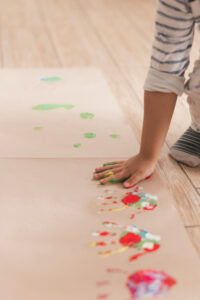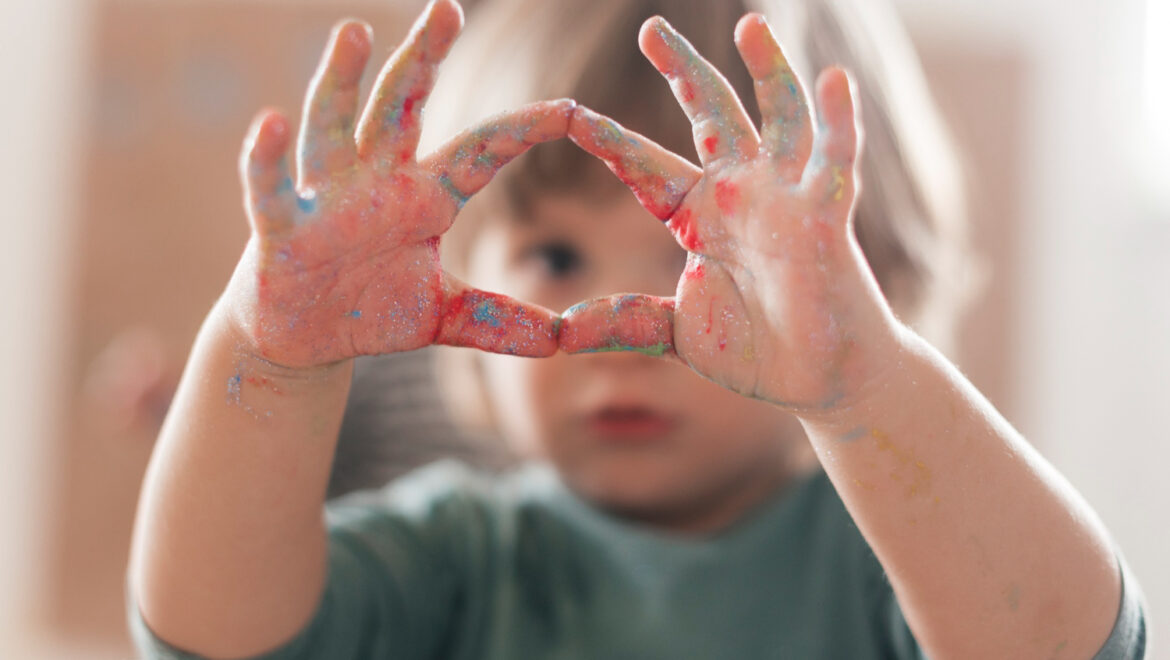Finger painting is a simple and fun activity that greatly benefits a child’s development at any age. Although it can be messy (which is why some parents avoid it), the many benefits make the mess worth it.
You don’t need many supplies for this activity. Kids use their fingers instead of brushes, which makes it more fun. All you need is some suitable paint, paper, and a bit of willingness to get messy.
What are the Benefits of Finger Painting for Kids?
-
Self-expression

When children paint, they learn to show their feelings through colors and pictures. You can ask your child to pick a color that matches their current mood. For example, they might choose red if they’re angry or green if they’re happy. Once they put their feelings on paper, they may find it easier to talk about them and learn to manage their emotions.
Also, finger painting can be done with other kids. This helps children share their feelings and understand and respect others’ emotions. It also helps them learn how to cooperate in a group.
-
Finger Painting Improves Sensory Learning
Finger painting engages all the senses, encouraging children to use their sight, smell, hearing, and touch while they play and learn. By touching and seeing colors, they improve their memory, visualization, and understanding of the difference between physical and abstract objects. Exploring paint, textures, and prints helps children develop sensory integration, which is beneficial for learning complex math and language concepts later on.
If you are worried about your child eating the paint, making it edible is a safe option. Though it requires more effort, it provides a wonderful experience that also enhances their sense of taste. You can use yogurt, blueberries, carrots, or buy natural food coloring.
-
Finger Painting Encourages Intellectual Development
Finger painting helps children learn about colors, self-identity, and experimentation, which boosts their thinking skills and intellectual growth. As they play with paint, move around, and mix colors, their minds stay active and engaged. Finger painting develops both sides of the brain and teaches kids how to use them together.
-
Finger Painting Coordinates Hand and Eye

Finger painting helps improve a child’s hand-eye coordination. It also strengthens their finger and hand muscles, which is important for developing pre-writing and other essential life skills.
-
Finger Painting Boosts Imagination and Creativity
One of the best things about finger painting is that kids love it. They dip their fingers in paint and use them to create pictures on paper. It can be messy, but that mess is part of the fun. Playing with colors, patterns, and the squishy texture of paint encourages children’s creativity and freedom. Since they focus on the process, not the final result, they can enjoy finger painting even without special talent.
Finger painting uses the VAK (Visual, Auditory, and Kinesthetic) method, which helps kids learn in the way that suits them best. It improves memory by engaging both sides of the brain. This is why finger painting is a key activity in our programs. Find out more about these programs here.
What Do You Need for the Finger Painting?
Here’s what you and your child need to start finger painting:
- Finger paint, whether store-bought or homemade (recipe below).
- Waterproof smock, apron, or old clothes that can get messy.
- An easy-to-clean painting surface, like a large sheet of paper, an old tray, or a smooth table or benchtop.
- Cleaning supplies: sponges, a bucket of soapy water, and a towel for drying hands.
Depending on the child’s age, you can also suggest mixing colors together to create new ones. It can be a magical experience, and they’ll also learn interesting concepts from it at an early stage!
How to Finger Paint with Children
Once you’ve prepared your painting area and cleaning supplies, it’s time to start being creative. Here are some ideas to try:
- Spread paint on the paper, tray, or table and let your child create patterns using their hands and fingers.
- Join in the fun! If your child is drawing squiggly lines, try making some yourself.
- Talk about what’s happening and describe the textures and colors of the paint.
- Play music while you paint. Encourage your child to paint based on how the music makes them feel.
- Add sand to the paint to make it more interesting and create texture.
- Make prints of the patterns by pressing clean sheets of paper onto the painted surface.
While you’re making different patterns, it’s a good idea to talk to the child about what they’re doing. For example, if they make blue dots, you can point out how nice those blue dots look! This helps introduce new words, improve communication, and more. Sharing this activity can also create opportunities for teaching moments with the child. You can talk about various topics that are suitable for their age without sounding too serious. It might be the perfect time for the child to open up about their feelings and thoughts, and for you to understand them better.
Before we finish, here’s a recipe for making finger paint at home.
Homemade Finger Paint Recipe
To make finger paint at home, you only need boiling water, cornstarch, and food coloring.
Start by mixing about half a cup of cornstarch with some cold water in a bowl until it forms a paste. Gradually add boiling water and keep stirring until you get the right consistency. Let it cool down. Once cooled, divide the mixture into portions and add different food coloring to each portion to create paints in various colors.
Summary
The benefits of finger painting for young children are significant. Just make sure they don’t put the paint in their mouths. For very young kids, you can even make edible paint using yogurt and food coloring, which is safe if ingested.
As for the mess they might make, but stains are good! After painting, encourage them to clean up and put everything away properly. This helps to teach responsibility and important life skills.
At Cambridge Kinderland, we focus on children’s overall development. We encourage children to explore, interact, and express their creativity through purposeful play.


Add Comment